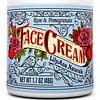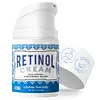What's inside
What's inside
 Key Ingredients
Key Ingredients

 Benefits
Benefits

 Concerns
Concerns

 Ingredients Side-by-side
Ingredients Side-by-side

Petroleum Distillates
SolventAloe Barbadensis Leaf Juice
Skin ConditioningGlycerin
HumectantPersea Gratissima Oil
Skin ConditioningEmulsifying Wax Nf
Limnanthes Alba Seed Oil
Skin ConditioningPunica Granatum Fruit Extract
AntioxidantCitrus Aurantium Dulcis Fruit Extract
MaskingCitrus Limon Fruit Extract
MaskingVaccinium Macrocarpon Fruit Extract
AstringentTocopherol
AntioxidantCalcium Ascorbate
AntioxidantEthylhexylglycerin
Skin ConditioningPhenoxyethanol
PreservativeUbiquinone
AntioxidantRetinol
Skin ConditioningThioctic Acid
AntioxidantPanthenol
Skin ConditioningPantothenic Acid
Skin ConditioningNiacinamide
SmoothingCanola Oil
EmollientLecithin
EmollientCitric Acid
BufferingPetroleum Distillates, Aloe Barbadensis Leaf Juice, Glycerin, Persea Gratissima Oil, Emulsifying Wax Nf, Limnanthes Alba Seed Oil, Punica Granatum Fruit Extract, Citrus Aurantium Dulcis Fruit Extract, Citrus Limon Fruit Extract, Vaccinium Macrocarpon Fruit Extract, Tocopherol, Calcium Ascorbate, Ethylhexylglycerin, Phenoxyethanol, Ubiquinone, Retinol, Thioctic Acid, Panthenol, Pantothenic Acid, Niacinamide, Canola Oil, Lecithin, Citric Acid
Aloe Barbadensis Leaf Juice
Skin ConditioningWater
Skin ConditioningIsopropyl Palmitate
EmollientHelianthus Annuus Seed Oil
EmollientGlyceryl Stearate
EmollientCetyl Alcohol
EmollientCassia Angustifolia Seed Extract
Skin ConditioningStearic Acid
CleansingGlycerin
HumectantSimmondsia Chinensis Seed Oil
EmollientPentylene Glycol
Skin ConditioningTocopheryl Acetate
AntioxidantCaesalpinia Spinosa Gum
Skin ConditioningButyrospermum Parkii Butter
Skin ConditioningPanthenol
Skin ConditioningXanthan Gum
EmulsifyingPolysorbate 20
EmulsifyingCamellia Sinensis Leaf Extract
AntimicrobialAlcohol
AntimicrobialRetinol
Skin ConditioningLecithin
EmollientSalix Alba Bark Extract
AstringentEquisetum Arvense Extract
AstringentTaraxacum Officinale Extract
Skin ConditioningCentella Asiatica Extract
CleansingGeranium Maculatum Extract
TonicPhenoxyethanol
PreservativeEthylhexylglycerin
Skin ConditioningAloe Barbadensis Leaf Juice, Water, Isopropyl Palmitate, Helianthus Annuus Seed Oil, Glyceryl Stearate, Cetyl Alcohol, Cassia Angustifolia Seed Extract, Stearic Acid, Glycerin, Simmondsia Chinensis Seed Oil, Pentylene Glycol, Tocopheryl Acetate, Caesalpinia Spinosa Gum, Butyrospermum Parkii Butter, Panthenol, Xanthan Gum, Polysorbate 20, Camellia Sinensis Leaf Extract, Alcohol, Retinol, Lecithin, Salix Alba Bark Extract, Equisetum Arvense Extract, Taraxacum Officinale Extract, Centella Asiatica Extract, Geranium Maculatum Extract, Phenoxyethanol, Ethylhexylglycerin
 Reviews
Reviews

Ingredients Explained
These ingredients are found in both products.
Ingredients higher up in an ingredient list are typically present in a larger amount.
Aloe Barbadensis Leaf Juice comes from leaves of the aloe plant. Aloe Barbadensis Leaf Juice is best known for helping to soothe sunburns. It is also anti-inflammatory, moisturizing, antiseptic, and can help heal wounds.
Aloe is packed with good stuff including Vitamins A, C, and E. These vitamins are antioxidants, which help fight free-radicals and the damage they may cause. Free-radicals are molecules that may damage your skin cells, such as pollution.
Aloe Barbadensis Leaf Juice also contains sugars. These sugars come in the form of monosaccharides and polysaccharides, folic acid, and choline. These sugars are able to help bind moisture to skin.
It also contains minerals such as calcium, 12 anthraquinones, fatty acids, amino acids, and Vitamin B12.
Learn more about Aloe Barbadensis Leaf JuiceEthylhexylglycerin (we can't pronounce this either) is commonly used as a preservative and skin softener. It is derived from glyceryl.
You might see Ethylhexylglycerin often paired with other preservatives such as phenoxyethanol. Ethylhexylglycerin has been found to increase the effectiveness of these other preservatives.
Glycerin is already naturally found in your skin. It helps moisturize and protect your skin.
A study from 2016 found glycerin to be more effective as a humectant than AHAs and hyaluronic acid.
As a humectant, it helps the skin stay hydrated by pulling moisture to your skin. The low molecular weight of glycerin allows it to pull moisture into the deeper layers of your skin.
Hydrated skin improves your skin barrier; Your skin barrier helps protect against irritants and bacteria.
Glycerin has also been found to have antimicrobial and antiviral properties. Due to these properties, glycerin is often used in wound and burn treatments.
In cosmetics, glycerin is usually derived from plants such as soybean or palm. However, it can also be sourced from animals, such as tallow or animal fat.
This ingredient is organic, colorless, odorless, and non-toxic.
Glycerin is the name for this ingredient in American English. British English uses Glycerol/Glycerine.
Learn more about GlycerinLecithin is a term for a group of substances found in the cell membranes of plants, animals, and humans. They are made up of mixture of phospholipids.
This ingredient has emollient and emulsifying properties.
As an emollient, lecithen helps soften the skin and creates a barrier to keep moisture in.
As an emulsifier, it also helps prevent water and oil ingredients from separating. Lecithin can also help ingredients be better absorbed by the skin.
This is because the phospholipids in lecithin produce liposomes. Liposomes help other ingredients get through the skin barrier.
Depending on the source of this ingredient, lecithin may not be fungal acne safe. This is because some sources of lecithin come from soybean oil, which may feed the malassezia yeast that feeds fungal acne.
We recommend reaching out to the brand you are purchasing from to inquire about the source of their lecithin.
Some other names for this ingredient include soy lecithin and deoiled soy lecithin.
Learn more about LecithinPanthenol is a common ingredient that helps hydrate and soothe the skin. It is found naturally in our skin and hair.
There are two forms of panthenol: D and L.
D-panthenol is also known as dexpanthenol. Most cosmetics use dexpanthenol or a mixture of D and L-panthenol.
Panthenol is famous due to its ability to go deeper into the skin's layers. Using this ingredient has numerous pros (and no cons):
Like hyaluronic acid, panthenol is a humectant. Humectants are able to bind and hold large amounts of water to keep skin hydrated.
This ingredient works well for wound healing. It works by increasing tissue in the wound and helps close open wounds.
Once oxidized, panthenol converts to pantothenic acid. Panthothenic acid is found in all living cells.
This ingredient is also referred to as pro-vitamin B5.
Learn more about PanthenolPhenoxyethanol is a preservative that has germicide, antimicrobial, and aromatic properties. Studies show that phenoxyethanol can prevent microbial growth. By itself, it has a scent that is similar to that of a rose.
It's often used in formulations along with Caprylyl Glycol to preserve the shelf life of products.
Retinol is a gold-standard ingredient for anti-aging. It is a form of Vitamin A and belongs to the class of retinoids that also includes tretinoin.
Why is retinol famous?
It has the most scientific studies backing up its skin benefits out of all the non-prescription ingredients.
Retinol is proven to:
This is why retinol is effective at removing wrinkles, fading dark spots, treating acne, and reducing the appearance of pores.
Studies show retinol is less effective when exposed to UV. Be sure to look for appropriate packaging to keep your retinol potent (similar to Vitamin C).
Using retinol or any retinoids will increase sun-sensitivity in the first few months. Though studies show retinoids increase your skin's natural SPF with continuous use, it is best to always wear sunscreen and sun-protection.
We recommend speaking with a medical professional about using this ingredient during pregnancy.
Retinol may cause irritation in some people, so be sure to patch test. Experts recommend 'ramping up' retinol use: start using this ingredient once a week and work up to using it daily.
Read about Tretinoin
Learn more about Retinol